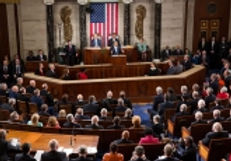Mr.
Fallman
Check and Balances
Like Baron de Montequieu said, "powers of the government should be separate yet equal." In order to keep the powers separate, each branch has their own specific powers. To make sure neither branch gains more power than the other, a set of 'checks' , or powers to keep the other branches in check, are given to each branch.



Article 1- Legislative Branch
Checks and Balances of the Legislative Branch
The Legislative Branch is given the powers to make the laws. It has the following checks ON the Executive Branch:
-May override presidential vetoes with a two-thirds vote
-Has the power over the money to actually fund any executive actions
-May remove the president through impeachment
-Senate approves treaties
-Senate approves presidential appointments
The Legislative Branch has the following checks ON the Judicial Branch:
-Creates lower courts
-May remove judges through impeachment
-Senate approves appointments of judges
Article 2 - Executive Branch
The Executive Branch has the following checks ON the Legislative Branch:
-
Veto power
-
Ability to call special sessions of Congress
-
Can recommend legislation
-
Can appeal to the people concerning legislation and more
-
The Executive Branch has the following check ON the Judicial Branch:
-
President appoints Supreme Court
-
President appoints other federal judges
Article 3 - Judicial Branch
Checks and Balances of the Judicial Branch
The Judicial Branch has the following checks ON the Executive Branch:
-Judges, once appointed for life, are free from controls from the executive branch.
-Courts can judge executive actions to be unconstitutional through the power of judicial review.
The Judicial Branch has the following check ON the Legislative Branch:
-Courts can judge legislative acts to be unconstitutional.
The American system of checks and balances has worked well over the course of America's history. Even though some huge clashes have occurred when vetoes have been overridden or appointees have been rejected, these occasions are rare.
The system was meant to keep the three branches in balance. Even though there have been times when one branch has risen preeminent, overall the three branches have achieved a workable balance with no one branch holding all the governmental power.